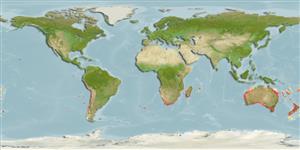Teleostei (teleosts) >
Gonorynchiformes (Milkfishes) >
Gonorynchidae (Beaked salmons)
Etymology: Gonorynchus: Greek, gonia (γονια) = angle, corner + Greek, rhyngchos (or rhúnkhos - ῥύγχος) = snout (Ref. 45335).
More on author: Linnaeus.
Environment: milieu / climate zone / depth range / distribution range
Ecology
Marine; demersal; depth range 0 - 200 m (Ref. 5755). Tropical; 15°S -
Southeast Atlantic: off southern Africa from the Skeleton Coast, Namibia round Cape of Good Hope to Natal, South Africa. Reported from Mozambique (Ref. 5213). Apart from the St. Helena, it has not been recorded elsewhere in the Atlantic. Western Pacific: Japan (Ref. 559), Chesterfield Islands (Ref. 11897), southern Australia and New Zealand (Ref. 4537). Eastern Pacific: Chile (Ref. 3975).
Size / Weight / Age
Maturity: Lm ? range ? - ? cm
Max length : 60.0 cm TL male/unsexed; (Ref. 5288); common length : 55.0 cm NG male/unsexed; (Ref. 5755)
Inhabits sandy bottoms along the shoreline (Ref. 5213) to depths of 200 m (Ref. 5755). Nocturnal, found buried in sand or mud during the day (Ref. 5755). Feeds on benthic and burrowing invertebrates (Ref. 5755). Pelagic young preyed upon by seabirds or found ashore during bad weather (Ref. 3975). Marketed fresh (Ref. 3411).
Life cycle and mating behavior
Maturity | Reproduction | Spawning | Eggs | Fecundity | Larvae
Whitehead, P.J.P., 1984. Gonorhynchidae. In W. Fischer and G. Bianchi (eds.) FAO species identification sheets for fishery purposes. Western Indian Ocean fishing area 51. Vol. 2. [pag. var.] FAO, Rome. (Ref. 3411)
IUCN Red List Status (Ref. 130435: Version 2024-2)
Threat to humans
Harmless
Human uses
Fisheries: commercial
Tools
Special reports
Download XML
Internet sources
Estimates based on models
Preferred temperature (Ref.
123201): 14 - 25.4, mean 17.4 °C (based on 324 cells).
Phylogenetic diversity index (Ref.
82804): PD
50 = 0.5625 [Uniqueness, from 0.5 = low to 2.0 = high].
Bayesian length-weight: a=0.00389 (0.00180 - 0.00842), b=3.12 (2.94 - 3.30), in cm total length, based on all LWR estimates for this body shape (Ref.
93245).
Trophic level (Ref.
69278): 3.3 ±0.5 se; based on diet studies.
Fishing Vulnerability (Ref.
59153): Moderate vulnerability (44 of 100).
